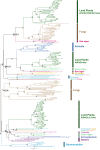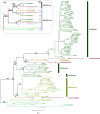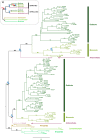The tree of life of polyamine oxidases
- PMID: 33082384
- PMCID: PMC7576179
- DOI: 10.1038/s41598-020-74708-3
The tree of life of polyamine oxidases
Abstract
Polyamine oxidases (PAOs) are characterized by a broad variability in catalytic properties and subcellular localization, and impact key cellular processes in diverse organisms. In the present study, a comprehensive phylogenetic analysis was performed to understand the evolution of PAOs across the three domains of life and particularly within eukaryotes. Phylogenetic trees show that PAO-like sequences of bacteria, archaea, and eukaryotes form three distinct clades, with the exception of a few procaryotes that probably acquired a PAO gene through horizontal transfer from a eukaryotic donor. Results strongly support a common origin for archaeal PAO-like proteins and eukaryotic PAOs, as well as a shared origin between PAOs and monoamine oxidases. Within eukaryotes, four main lineages were identified that likely originated from an ancestral eukaryotic PAO before the split of the main superphyla, followed by specific gene losses in each superphylum. Plant PAOs show the highest diversity within eukaryotes and belong to three distinct clades that underwent to multiple events of gene duplication and gene loss. Peptide deletion along the evolution of plant PAOs of Clade I accounted for further diversification of function and subcellular localization. This study provides a reference for future structure-function studies and emphasizes the importance of extending comparisons among PAO subfamilies across multiple eukaryotic superphyla.
Conflict of interest statement
The authors declare no competing interests.
Figures





Similar articles
-
Molecular evolution of the polyamine oxidase gene family in Metazoa.BMC Evol Biol. 2012 Jun 20;12:90. doi: 10.1186/1471-2148-12-90. BMC Evol Biol. 2012. PMID: 22716069 Free PMC article.
-
Defining novel plant polyamine oxidase subfamilies through molecular modeling and sequence analysis.BMC Evol Biol. 2019 Jan 21;19(1):28. doi: 10.1186/s12862-019-1361-z. BMC Evol Biol. 2019. PMID: 30665356 Free PMC article.
-
Functional diversity inside the Arabidopsis polyamine oxidase gene family.J Exp Bot. 2011 Jan;62(3):1155-68. doi: 10.1093/jxb/erq341. Epub 2010 Nov 16. J Exp Bot. 2011. PMID: 21081665
-
Archaea and the origin of eukaryotes.Nat Rev Microbiol. 2017 Nov 10;15(12):711-723. doi: 10.1038/nrmicro.2017.133. Nat Rev Microbiol. 2017. PMID: 29123225 Review.
-
Origin of eukaryotes from within archaea, archaeal eukaryome and bursts of gene gain: eukaryogenesis just made easier?Philos Trans R Soc Lond B Biol Sci. 2015 Sep 26;370(1678):20140333. doi: 10.1098/rstb.2014.0333. Philos Trans R Soc Lond B Biol Sci. 2015. PMID: 26323764 Free PMC article. Review.
Cited by
-
Facts, Dogmas, and Unknowns About Mitochondrial Reactive Oxygen Species in Cancer.Antioxidants (Basel). 2024 Dec 19;13(12):1563. doi: 10.3390/antiox13121563. Antioxidants (Basel). 2024. PMID: 39765891 Free PMC article. Review.
-
Plant Peroxisomal Polyamine Oxidase: A Ubiquitous Enzyme Involved in Abiotic Stress Tolerance.Plants (Basel). 2023 Feb 1;12(3):652. doi: 10.3390/plants12030652. Plants (Basel). 2023. PMID: 36771734 Free PMC article. Review.
-
Polyamine Oxidase-Generated Reactive Oxygen Species in Plant Development and Adaptation: The Polyamine Oxidase-NADPH Oxidase Nexus.Antioxidants (Basel). 2022 Dec 17;11(12):2488. doi: 10.3390/antiox11122488. Antioxidants (Basel). 2022. PMID: 36552696 Free PMC article. Review.
-
The Molecular Role of Polyamines in Age-Related Diseases: An Update.Int J Mol Sci. 2023 Nov 17;24(22):16469. doi: 10.3390/ijms242216469. Int J Mol Sci. 2023. PMID: 38003659 Free PMC article. Review.
-
Polyamine oxidation enzymes regulate sexual mating/filamentation and pathogenicity in Sporisorium scitamineum.Mol Plant Pathol. 2024 Sep;25(9):e70003. doi: 10.1111/mpp.70003. Mol Plant Pathol. 2024. PMID: 39235122 Free PMC article.
References
-
- Hamana K, Niitsu M, Samejima K, Matsuzaki S. Linear and branched pentaamines, hexaamines and heptaamines in seeds of Vicia sativa. Phytochemistry. 1991;30:3319–3322. doi: 10.1016/0031-9422(91)83201-U. - DOI
Publication types
MeSH terms
Substances
LinkOut - more resources
Full Text Sources

